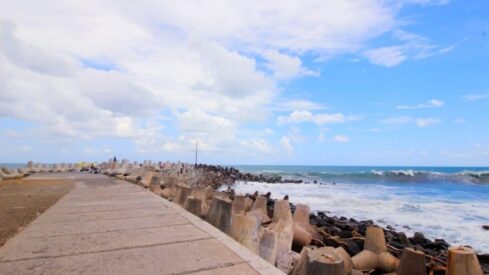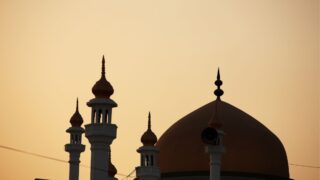Indonesia is blessed with the greatest and most diverse biological resources in the world, after Brazil. This natural wealth can be sustainably utilized for the welfare of the population. Unfortunately enough, however, the country has not been able to successfully use the enormous natural wealth to improve the welfare of her people.
In 1996, before Indonesia was hit by the on-going economic crisis, the number of people under the poverty line was 22.5 million (around 11.3 per cent of the total population). According to data from the National Bureau of Statistics, Indonesia’s population under the poverty line increased drastically to around 79.4 million people (about 39 per cent) in 1999. And up to now, Indonesia has not yet recovered from the prolonged economic crisis marked by a high inflation rate, the increasing number of jobless people, and the devaluation of the country’s currency (Rupiah) against the US dollar in particular.
Mega Center for Biodiversity
Biodiversity is a highly valuable asset, and has been the lifeblood of Indonesia’s traditional multi-ethnic population. Biological diversity, or biodiversity, is the term used to explain the variety, variability and uniqueness of genes, species and ecosystems. With its enormous wealth of biotic resources, Indonesia has a great potential to sustainably utilize her biological resources to meet the basic needs of the population: food, clothing, housing and medicine.
Indonesia is the largest archipelago in the world, located between two oceans, the Pacific and the Indian, and bridging two continents, Asia and Australia. It consists of more than 17,000 islands, including five main islands – Java, Kalimantan (Borneo), Irian Jaya (Papua), Sumatera and Sulawesi.
Scientists acknowledge Indonesia, which has a population of around 220 million, as one of the world’s ‘mega centers’ of biodiversity for her wide range of natural habitats, rich flora and fauna species.
About 17 per cent of all species in the world can be found in Indonesia, although it forms only 1.3 per cent of the Earth’s land surface. The country has around 515 mammal species, 122 species of butterflies, 600 species of reptiles, 1531 species of birds, 270 species of amphibians, and 28,000 flowering plants.
Prehistoric Indonesian Dragons
The Komodo dragon is the world’s rarest and most primitive reptile
Do you remember Jurassic Park? Come to Indonesia and meet the Komodo dragon (Varanus komodoensis). Komodo is one of the world’s rarest and most primitive reptiles, with a prehistoric appearance. The Komodo dragon, the world’s largest lizard, can grow to three meters long and weigh up to 60 kilograms, and is found in western Flores and the islands of Komodo, Padar and Rinca, East Nusa tenggara, and eastern Indonesia.
The exact number of Komodo dragons is unknown, but estimates range from 3,000 to 6,000. Since 1931 it has been classified as an endangered species. The habitat of the endemic animal is decreasing due to lack of protection and the increasing illegal logging activities.
Unsurpassed Plant Life
The rich flora of Indonesia includes many unique varieties of tropical plant life in various forms. Rafflesia arnoldi, which is found only in certain parts of Sumatera and Kalimantan, is the largest flower in the world. In Irian Jaya, 2500 different orchids are known; among them is the world’s largest orchid, Grammatophyllum papuanus, with three-meter sprays of orange blossoms.
Rafflesia arnoldi is the largest flower in the world
About 6,000 species of plants are known to be used directly or indirectly by the people. The use of plants in the production of traditional herbal medicine or “Jamu” is very common.
As the largest tropical forest in the world, Indonesia has species-rich forests that harbor the world’s greatest diversity of palms; more than 400 species or 70 per cent of the world’s dipterocarp species (the most valuable timer species in Southeast Asia) including ebony, teakwood, and sandalwood; and 122 species of bamboo. The country also has over 350 species of rattan and produces three-quarters of the world’s rattan cane.
Many Challenges to Indonesia’s Biodiversity
Despite the good chances and opportunities referred to above, Indonesia is confronted with some real challenges, including a high population rate, low levels of awareness, the absence of environmental
law enforcement, weak institutional infrastructure and inadequate development of science and technology concerned with conservation and utilization of biodiversity.
The country’s forests, estimated to cover over 130 million hectares, which are the main home of Indonesia’s biodiversity, have been considered to be over-exploited both by legal forest concession holders and illegal logging activities. Around 1.6 to 2.1 million hectares of forests are destroyed every year in Indonesia.
It is worth mentioning that the Tesso Nilo conservation area in Riau Province, Sumatra, is one of the country’s richest biodiversity forests. However, Tesso Nilo, which is inhabited among others by rare Sumatran tigers and elephants, has also been damaged seriously due to logging activities, particularly for paper and pulp industries. Clearing projects do not only threaten natural habitats, food chains and the survival of the Sumatran tiger and elephant, but also that of orangutans, the large apes of Kalimantan (Borneo Island).
Besides this man-made ‘disaster’, forest fires are also ‘a main enemy’ that often hit the country. Experts say that actual and potential harm to Indonesia’s jungles from forest fires is enormous. Forest fires are usually triggered by cheap land clearing projects undergone by the forest concession holders and by the El Nino natural phenomenon that brings severe drought to Indonesia.
Sumatran tiger
A bitter lesson was learned from the 1982-83 and 1994 forest fires that destroyed 6.4 million hectares of forests, especially in East Kalimantan.
Ismi Haddad, Executive Director of the Indonesian Biological Diversity Foundation, Kehati, told workshop participants in Jakarta in 2000, that many people were not aware that forest fires posed very serious problems to the preservation of biological diversity. Thousands of flora and fauna species, including the rare ones, were destroyed during the forest fires.
Crop Biodiversity Lures Colonialists
Indonesia is also a center of crop biodiversity with a wide range of varieties such as banana (Musa spp.), nutmeg (Myristica fragans) and cloves (Syzygium aromaticum), which attracted Dutch, Portuguese and British colonial rulers to come and occupy Indonesia in the 15th century. In the colonial time, nutmeg was the most valuable commodity after silver and gold for most Europeans.
According to Setijati D. Sastrapradja, also from the Kehati foundation, the Russian biologist Vavilov traveled around the world in 1930 to identify economic plants from many countries. According to the Russian scientist, there were eight centers of economic plants in the world. But his student, Chukovski, discovered there were 12 centers rather than eight, including the “Indonesia-Indochina center of Vavilov”. Vavilov’s study identified 3,500 edible plants, including four main edible plants such as rice or paddy, which basically feed the world. Sugarcane, banana and coconut trees are among edible plants originally growing in Indonesia. Indonesia is currently not the world’s main producers of these commodities, however.
It is quite ironic that in Indonesia, 1,500 local varieties of rice have disappeared in the past 15 years. Research on rice conducted by the International Rice Research Institute (IRRI) last year discovered the remarkable ability of biodiversity to help farmers improve their livelihoods while protecting the environment and their health. Based on its research in China, IRRI has found that farmers can use biodiversity to improve their incomes and profitability while controlling pests and diseases with fewer pesticide applications. The Philippines-based IRRI has made biodiversity a central research focus for more than a decade and runs projects exploring its potential in most Asian nations.
The Right of a Nation
Borneo Island is famous for its orangutans
As the second largest megabiodiversity nation after Brazil, Indonesia has placed great interest in the preservation of biodiversity and the protection of its people’s rights over knowledge of the science. Indonesia was among the first signatories of the Earth Summit Convention on Biodiversity and was represented directly by the then President Soeharto.
However the issue of biodiversity is not only a question of preservation, but also the right of the nation and her people, especially the indigenous population who benefit less from the country’s biological wealth than those who monopolize the technologies to process medicinal plants, mostly in the West.
Another discouraging fact is that efforts to conserve biodiversity and to rehabilitate degradation go on at a lesser rate in comparison with that of the depletion and erosion of the biotic/genetic resources.
Indonesia’s former minister for population and environment, Prof. Dr. Emil Salim, once said that empowerment of the Indonesian people is imperative for the preservation and survival of its biodiversity. He also commented that poverty tends to push people to harm nature, especially the forests. So, while Indonesia is still busy fighting against economic crisis and poverty, the environment will remain in the last of the priority list and continue to be a victim.
By Hani Mumtazah – Jakarta
Sources:
Kyodo, 2003 – Gap on Environment in Rich, Poor Nations Evident: World Bank
AFP, 1997 – Jungle Animals Exact Lethal Revenge for Indonesian Fires
2000 – Workshop on Biodiversity by Kehati Foundation
1998 – Biodiversity for the Survival of Humankind, the Government of Indonesia
1989- ANTARA, Fardah Assegaf – Tropical Rain Forest, A Curse or Blessing
1993, ANTARA, Fardah Assegaf – Acculturation Could Also Mean Loss of Biodiversity
2002 – IRRI – Biodiversity: Adding Value to Rice farming 2003, WWF Indonesia – Stop Forest Destruction
















